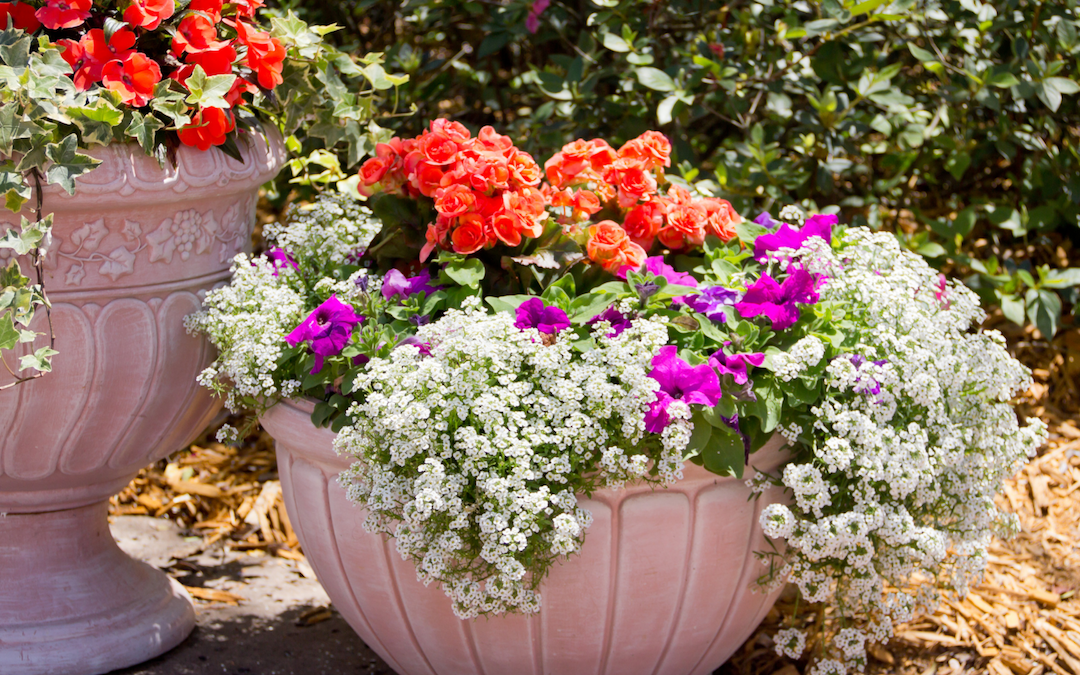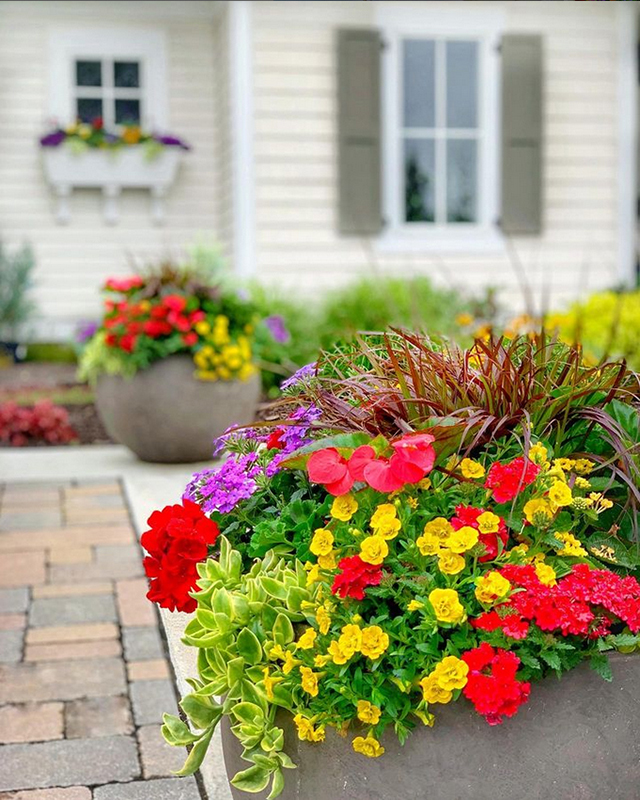To plant pots, start by choosing the right container and soil. Ensure proper drainage to avoid root rot.
Container gardening offers a versatile way to grow plants in limited spaces. Whether you have a small balcony or a large patio, planting in pots can bring greenery and beauty to your surroundings. Select containers that suit your plants’ needs and provide adequate drainage.
Use high-quality potting mix to support healthy growth. Arrange your pots to maximize sunlight exposure and maintain regular watering schedules. Fertilize periodically to replenish essential nutrients. Container gardening allows you to experiment with a variety of plants, from flowers to vegetables, making it an enjoyable and rewarding hobby.
:max_bytes(150000):strip_icc()/tips-for-growing-tomatoes-in-containers-848216-06-41ce3f715bd74adc94a18d6cbae3bf7c.jpg)
Credit: www.thespruce.com
Choosing The Right Pots
Choosing the right pots is crucial for successful container gardening. The pot you pick affects plant health, growth, and overall garden look. This guide helps you select the best pots for your plants.
Material Options
Different pot materials offer unique benefits. Understanding these can help you make an informed choice.
- Terracotta: These pots are classic and breathable, helping plants thrive. They can dry out quickly though.
- Plastic: Lightweight and affordable, plastic pots retain moisture well. They can overheat in direct sun.
- Ceramic: Beautiful and durable, ceramic pots are great for indoors. They can be heavy and pricey.
- Metal: Stylish and modern, metal pots are long-lasting. They can heat up and aren’t ideal for all plants.
- Wood: Natural and rustic, wood pots provide good insulation. They can rot without proper treatment.
Size And Drainage
Choosing the right size and ensuring proper drainage are key. Here’s what to consider:
| Consideration | Details |
|---|---|
| Size | Pots should be large enough for roots to grow. Small pots dry out faster, needing more water. |
| Drainage | Ensure pots have drainage holes. This prevents waterlogging and root rot. |
- Choose pots with at least one drainage hole.
- Use a saucer to catch excess water.
- Add gravel at the bottom for extra drainage.
Picking the right pots ensures healthy, happy plants in your garden. Select materials, sizes, and drainage wisely.
Selecting Suitable Plants
Choosing the right plants is key to successful container gardening. The ideal plants can thrive in your pots and produce beautiful results. Here are some tips on selecting suitable plants for your container garden.
Climate Considerations
Climate plays a crucial role in plant selection. Different plants thrive in different climates. Identify your local climate zone to choose plants that will flourish. For warm climates, consider drought-tolerant plants like succulents and cacti. In cooler climates, opt for hardy perennials.
The table below provides examples of suitable plants based on climate zones:
| Climate Zone | Suggested Plants |
|---|---|
| Warm | Succulents, Cacti, Lavender |
| Cool | Hardy Perennials, Ferns, Hostas |
| Temperate | Roses, Geraniums, Begonias |
Growth Patterns
Understanding plant growth patterns is essential for container gardening. Different plants have different growth habits. Some plants grow tall and need deep pots. Others spread out and need wide containers.
Here are some tips to consider:
- Tall plants: Use deep pots to support their roots.
- Spreading plants: Use wide containers for ample space.
- Trailing plants: Use hanging baskets or tall pots.
Consider the following growth patterns for popular container plants:
| Plant | Growth Pattern | Container Type |
|---|---|---|
| Tomato | Tall | Deep Pot |
| Strawberry | Spreading | Wide Container |
| Petunia | Trailing | Hanging Basket |
Choosing the right plants based on climate and growth patterns ensures a thriving container garden. Happy planting!
Preparing The Potting Mix
Creating the perfect potting mix is essential for healthy container plants. A well-prepared mix ensures your plants get the right nutrients and drainage. This section covers the key components and additives to include.
Soil Components
The base of your potting mix is crucial. Quality soil components help retain moisture and provide air space.
- Peat Moss: Retains moisture and provides a lightweight structure.
- Perlite: Improves drainage and aeration.
- Vermiculite: Holds water and nutrients, releasing them as plants need.
- Compost: Adds essential nutrients and beneficial microbes.
Nutrient Additives
Adding nutrients to your soil ensures your plants grow strong and healthy. Here are some key nutrient additives:
- Fertilizer: Use a balanced, slow-release fertilizer to provide continuous nutrients.
- Bone Meal: High in phosphorus, it aids root development and flowering.
- Blood Meal: Rich in nitrogen, it promotes lush, green growth.
- Wood Ash: Provides potassium and helps balance soil pH.
For the best results, mix these components thoroughly. Ensure your mix is light and airy, yet capable of holding moisture. This balance is key to successful container gardening.
Planting Techniques
To create a thriving container garden, use proper planting techniques. These methods ensure healthy growth and vibrant plants. Let’s explore the essential steps for successful container gardening.
Seedling Placement
Correct seedling placement is crucial for growth. Follow these steps:
- Dig a small hole in the soil.
- Gently place the seedling into the hole.
- Ensure the roots are fully covered with soil.
- Space seedlings according to their growth needs.
Spacing prevents overcrowding and ensures each plant gets enough light and nutrients.
Root Management
Managing roots is key to healthy container plants. Follow these tips:
- Trim long roots before planting.
- Ensure roots are spread out in the soil.
- Do not pack the soil too tightly around the roots.
Proper root management helps plants absorb water and nutrients effectively.
| Step | Action | Reason |
|---|---|---|
| 1 | Trim long roots | Prevents root circling |
| 2 | Spread roots | Encourages even growth |
| 3 | Loosen soil | Improves root health |
By following these planting techniques, you can ensure a healthy and vibrant container garden.
Watering Strategies
Proper watering is crucial for container gardening success. Plants in pots need consistent moisture but not too much. Learn how to balance your watering strategies to keep your plants healthy and thriving.
Frequency And Amount
Watering frequency depends on the plant type, pot size, and weather. Typically, water container plants once a day during hot weather. In cooler months, reduce watering to every few days.
Water plants until the water drains from the bottom. This ensures the soil is thoroughly moist. Use a watering can with a narrow spout for targeted watering. Avoid splashing water on leaves to prevent disease.
| Plant Type | Watering Frequency |
|---|---|
| Succulents | Once a week |
| Herbs | Every other day |
| Flowers | Daily |
Signs Of Overwatering
Overwatering is a common mistake in container gardening. Look for these signs to identify overwatering:
- Yellowing leaves
- Wilting despite moist soil
- Foul odor from the soil
- Mold or algae growth on the soil surface
If you notice these signs, reduce watering immediately. Allow the soil to dry out before the next watering session. Consider using a soil moisture meter to check soil moisture levels.
By following these watering strategies, your container garden will flourish. Regularly check your plants and adjust watering as needed.

Credit: www.rainbowgardens.biz
Fertilization Tips
Proper fertilization is crucial for thriving container gardens. It ensures plants get essential nutrients. Follow these tips for the best results. Learn about types of fertilizers and application timing to maximize plant health.
Types Of Fertilizers
There are many types of fertilizers available. Choosing the right one is key. Here are common options:
- Liquid Fertilizers: Easy to apply and quick-acting.
- Granular Fertilizers: Slow-release and long-lasting.
- Organic Fertilizers: Eco-friendly and improve soil structure.
- Synthetic Fertilizers: Provide precise nutrient levels.
| Type | Benefits |
|---|---|
| Liquid | Fast nutrient absorption |
| Granular | Extended nutrient release |
| Organic | Improves soil health |
| Synthetic | Exact nutrient formulas |
Application Timing
Timing is essential for effective fertilization. Here are some guidelines:
- Early Spring: Start fertilizing as new growth appears.
- Mid-Summer: Provide a mid-season nutrient boost.
- Late Fall: Fertilize lightly before the first frost.
Always follow the instructions on the fertilizer package. Over-fertilizing can harm plants. Regularly check your plants for signs of nutrient deficiencies. Adjust your fertilization schedule as needed. Happy container gardening!
Pest And Disease Control
Container gardening can be a joy, but pests and diseases can spoil it. Keeping your plants healthy is key to a successful garden. Let’s dive into some tips for pest and disease control.
Common Issues
Understanding common issues helps in keeping your plants safe.
- Aphids: These tiny insects suck sap from plants.
- Spider mites: They cause yellow spots on leaves.
- Fungal infections: These can rot roots and leaves.
Preventative Measures
Follow these steps to prevent pests and diseases.
- Inspect plants: Check your plants daily for signs of pests.
- Proper watering: Water the soil, not the leaves.
- Clean pots: Wash pots before reusing them.
- Use mulch: Mulch helps keep soil healthy.
| Issue | Prevention |
|---|---|
| Aphids | Use insecticidal soap |
| Spider mites | Spray with water |
| Fungal infections | Avoid overhead watering |
Seasonal Care
Taking care of your potted plants throughout the year is crucial. Each season brings its own challenges and requirements. Follow these simple tips to keep your container garden thriving.
Winter Protection
Winter can be harsh for potted plants. To protect them, follow these steps:
- Move pots indoors or to a sheltered area.
- Use insulation materials like bubble wrap around pots.
- Water plants sparingly but don’t let the soil dry out.
- Ensure drainage holes are not blocked by ice.
Keep an eye on the weather. Cover plants with frost cloths if temperatures drop suddenly.
Summer Maintenance
Summer brings heat and intense sunlight. To keep your potted plants healthy, consider these tips:
- Water plants daily in the early morning or late evening.
- Place pots in partial shade to avoid direct sunlight.
- Use mulch to retain soil moisture.
- Fertilize plants every two weeks for optimal growth.
Keep an eye out for pests. Treat infestations promptly with natural remedies or insecticides.
| Season | Action |
|---|---|
| Winter | Move pots indoors, use insulation, water sparingly |
| Summer | Water daily, provide shade, use mulch, fertilize |

Credit: plaidsandpoppies.com
Frequently Asked Questions
How Do I Choose The Right Pot?
Choose a pot with drainage holes. Ensure it’s the right size for the plant. Use lightweight materials for easy movement.
What Soil Is Best For Container Gardening?
Use high-quality potting mix. It provides good drainage and nutrients. Avoid garden soil which is too dense.
How Often Should I Water Potted Plants?
Water when the top inch of soil is dry. Frequency varies by plant type and weather conditions.
Can I Grow Vegetables In Pots?
Yes, many vegetables thrive in pots. Choose compact varieties and ensure they receive adequate sunlight.
Conclusion
Planting pots can transform any space into a green oasis. Follow our tips for successful container gardening. Choose the right pot, soil, and plants for your environment. Regular watering and proper drainage are key. Enjoy the beauty and benefits of your thriving container garden.
Happy gardening!
